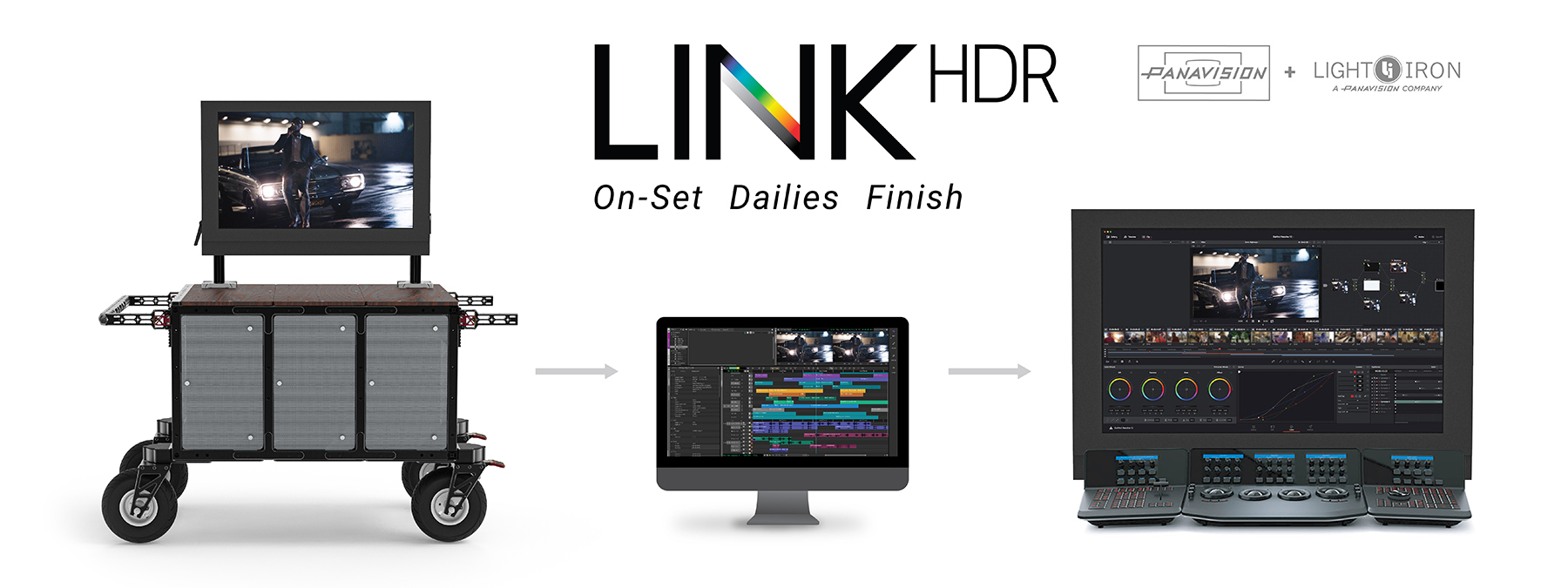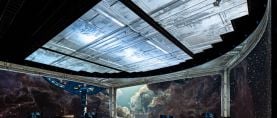
Panavision/Light Iron’s LINK HDR Offers HDR Pipeline Solution
Opening up access to high-dynamic range images on set will enable a more inclusive creative process and help deliver a more accurate final version of the cinematographer’s vision.
Opening up access to high-dynamic range images on set will enable a more inclusive creative process and help deliver a more accurate final version of the cinematographer’s vision.
On the evening of July 30 at the ASC Clubhouse in Hollywood, Panavision and its sister company Light Ironintroduced Society members and their guests to LINK HDR, an ecosystem that enables creatives – from the director and cinematographer through to the editor – to view content in HDR and SDR. The companies set up four LINK systems to demonstrate the system’s ability to show side-by-side and individual HDR and SDR images.
Panavision president/chief executive officer and ASC associate member Kim Snyder introduced the event, calling the Clubhouse an “incubator for innovation.”
“We try to come together and collaborate with you,” Snyder added, speaking directly to the many cinematographers in the room. “That way we can focus on the technology and you on the artistry.”
Light Iron co-founders Michael Cioni (also now Panavision senior vice president of innovation and an ASC associate member) and Katie Fellion (Light Iron head of business development), together described the rationale for developing LINK HDR and the details of how it works. “Over 150 million HDR devices are connecting and playing from OTT platforms every month,” said Fellion. “Because of that, we want to make sure we have an end-to-end HDR system, from on-setto editorial into finishing.” She noted that the number of HDR-capable devices will “increase astronomically” with smartphones and other mobile devices. “It will introduce billions of viewers to HDR.”
Cioni reported that, “the adoption of 4K HDR is happening over 60 percent faster than that of SD to HD.
“By the end of 2019, over 30 percent of North America will have 4K HDR TVs in the home. And the mobile device industry is only one or two cycles away from HDR, depending on the carrier. Once it becomes a global standard, how do we respond to that and make sure images look exceptional on set?”
He identified key collaborators who should be able to see HDR: the director, the cinematographer, the editor, VFX supervisor, colorist and consumer. “Today only the colorist and consumer have the tools to see images in HDR,” said Cioni. “We want to introduce HDR earlier in the pipeline.”
Being able to see dailies in HDR (and SDR) on set is a crucial LINK HDR component. “People often fall in love with the [look of] dailies,” said Cioni. “This sometimes means creatives have to fight for the look you want at the end of the chain. The challenge is how to make the dailies match the HDR on-set.” He emphasized that LINK HDR was developed with the help of cinematographers, singling out Theo van de Sande, ASC and Jim Frohna. The latter shot Amazon Studios’ series Transparent, which was the very first series ever fully mastered and delivered in HDR. The unfamiliarity of the process at the time, said Cioni, made Frohna and his colleagues think, “there has got to be a better way.”
Van de Sande reports that, in November of 2014, he “was the first to shoot 4K with the Panasonic VariCam 35 camera.” Cioni worked with Panasonic to develop post production with the camera. “Together with Light Iron, I set out to develop over the years a very strong workflow based on the dual recording possibilities of the VariCam 35,” Van de Sande says. “Specifically, I concentrated on getting on the set as close as possible to the final image and creating with the 2K proxy format a very efficient and economical workflow.” The result, says Van de Sande, is that it made it possible for him to work in 4K even when production companies didn’t need to deliver 4K. “This was not directly related to HDR workflow, but more to get the highest quality image in the most consistent, efficient and economical way to the final color timing,” he said. “Now, for Netflix, I am finishing the first 8K HDR feature, shot with the Panavision DXL2 camera, with a proxy 2K for a 4K post workflow shot, which, indirectly, brought new solutions for LINK.”
Cioni reported that LINK HDR, designed to be plug-and-play, has already been used for several productions since it deployed June 1. (A Panavision spokesperson said that the company is under NDA and not yet able to release the names of the projects that used the LINK system.) Cioni referred to an HDR evaluation conducted by consultant Gary Mandle, an ASC associate member and vice chair of the ASC Motion Imaging Technology Council’s Professional Monitor Display committee. “We came to the same conclusion as the ASC about which were the top monitors [for HDR],” he said. “Those are the ones we use for LINK On-Set.” More specifically, LINK relies on the Sony BVME171 17” HDR display, which displays up to 600 nits in 1080 and uses one toggle button to see HDR and SDR simultaneously or, one at a time, full screen. The Sony X310 31” monitor offers a 1,000-nit display at UHD or HD, and allows the user to see all four possible combinations simultaneously. The LINK HDROn-Set modular cart can be customized into virtually any size or shape cart for use on set.
Panavision and Light Iron worked with Portrait Displays’ CalMAN software to measure and profile the monitors before they go on set. “It’s a standardization we’re really excited about,” said Fellion. “We can get you a report – that can be emailed to you — based on DI tolerance calibration across the globe, managed by Light Iron and Panavision offices. You don’t have to worry as you switch from one location to another. If something goes wrong, you have the correct version of the last custody.” Cioni added that the CalMAN measurement software “holds everyone accountable. Uniform calibration standards are key to making this reliable.”

The LINK HDR On-Set system interacts with color correction on set. “LINK On-Set receives camera Log feeds and converts them to HDR and SDR,” explained Cioni. “The CDL feeds into LINK which is converted to HDR/SDR and the 709 video village. CDLs with LINK are one plug-and-play version, so you don’t have to manage multiple corrections.”
Fellion notes that Panavision/Light Iron, having partnered with ColorFront for simultaneous HDR and SDR deliveries to editorial, has also worked with editorial companies to create best processes for use with Avid, Apple, and Adobe NLEs. “This also travels to the mix room,” said Cioni. “LINK won’t intrude in your typical editorial workflow. For a screening or rough-cut review, you choose the HDR or SDR stream. The editors don’t have to change anything and we provide a calibration spec for their monitors to match, via CalMAN.”
To explain LINK HDR in finishing, Light Iron supervising colorist Ian Vertovec, who worked with cinematographer Amir Mokri on the 2019 Netflix movie Murder Mystery, noted wryly that, “in the DI suite, everything looks good until you see something better.
“Acquiring HDR on set can show you the potential of what you’re able to create,” Vertovec continued.“The more images you feed into Dolby Vision, the smarter it gets due to machine learning.” In Murder Mystery, the HDR was derived first, which Panavision/Light Iron recommends as the best way to achieve both versions. As a result, said Vertovec, “We’re seeing more SDR passes that are respectful to the original version.”
Cioni summarized that, although LINK HDR can involve the workflow from on-set to dailies and finishing, a user doesn’t have to choose to use LINK HDR for all those steps. “It’s an option, and you can elect to explore it,” he said. “We find the best results are when we use them together.”
Fellion added that LINK HDR is compatible with or without a DIT, with a live grading CDL workflow and that it also interfaces with a traditional SDR video village: “It improves workflow because you see the final product on set and editorial. It is better for VFX because you can see things that are invisible in SDR.”
“If you love HDR, we hope these tools help you love it more – and if you hate HDR, we hope these tools will help you hate it a little less,” said Cioni. “Instead of fighting the system we want to give you more ammunition to handle it.”
David Stump, ASC asked if there was a white paper on the process he could take to the creatives for a VFX-intensive production. Yes, said Cioni, who said there is a white paper and that his company will also publish the CalMAN specs. Stump asked if — hypothetically — there was another white paper for how to port lens data from the DXL2 and Prime 65s through visual effects. “Since you said ‘hypothetically,’” answered Cioni. “We think Apple’s XDR monitor might be the perfect HDR monitor for the VFX infrastructure to take off.”
Curtis Clark, ASC asked if LINK is compliant with ACES, especially since “more and more films are using it and it’s relevant to HDR. “Yes, I colored with ACES,” answered Vertovec. “Two of the carts [at the ASC presentation] were set up with live camera streams in ACES mode.”
As to pricing, the Panavision/Light Iron spokesperson said only that, “we intend to work closely with the requirements of each production to determine their unique configurations for the LINK HDR cart [examples here] and LINK HDR post services. Pricing will be determined by many factors including the complete camera rental package and post services.”






